
Image by Kike Arnaiz / Stocksy
December 31, 2022
Our editors have independently chosen the products listed on this page. If you purchase something mentioned in this article, we may
When it comes to setting up the home gym, we tend to focus entirely on the equipment. But an oh-so-important and oft-overlooked element of the home gym becomes glaringly apparent the minute you start a workout—and you’re standing on it.
Who wants to stress about dinging that hardwood with your new kettlebell, hammering your joints on unforgiving tile, or smushing your carpet with your gigantic treadmill when you’re trying to get your sweat on?
That’s where dedicated home gym flooring comes in. We worked alongside fitness and interior design experts to round up seven of the best options for specific workouts, so you’ll have the foundation you need (literally) for some serious training.
The best home gym flooring of 2023:
Reasons to get home gym flooring.
By tailoring your gym flooring to your preferred type of workout, you can ensure that everything—your home and body included—has the protection it needs.
“Proper flooring takes proper care of your body,” explains Paul Fischer, a certified personal trainer and owner of Framework Personal Training. A supportive, grippy surface will offer shock absorption and cushion your joints while also minimizing the risk of slipping and falling, no matter how sweaty you get.
Dropping a little money on a dedicated gym floor also protects your home, says Felicia Rish, senior commercial interior designer at Architects in Partnership. “If you drop a 20-pound kettlebell on hard surfaced flooring, you’ll probably have a new ding in your wood flooring or a chunk missing from your concrete floor,” Rish explains.
There’s also a psychological component to a good gym floor. “Your environment contributes to your success,” says Fischer. “A room that is set up for intentional exercise is another tool for goal setting. Just like studying in a quiet room, a proper gym creates positive habits.”
If you’re side-eyeing your carpet right this minute, keep in mind that many types of flooring can support a solid workout. “It’s perfectly safe to work out on existing home surfaces like laminate and carpet, though these can provide less grip than traditional rubber flooring,” explains Kerri Husk, sports therapist and owner of Huskie Sports Therapy & Performance. But if your current floor has no give (think tile and polished or bare concrete), certain workouts will require the addition of a good fitness mat at the very least.
How we picked.
While you can absolutely go the professional route, we looked for home gym flooring options that you can also DIY.
Price points for flooring can vary wildly, so we included options to suit different budgets.
Cross-training is a great way to work out. Many of the flooring options on our list will accommodate different kinds of fitness and come recommended by gym experts.
We looked for products that have high ratings and positive feedback from people who use them day in and day out.
Our picks for the best home gym flooring of 2023
Best for weight training: American Floor Mats Fit-Lock Rubber Flooring
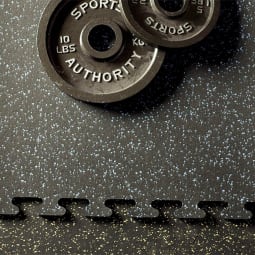
Pros
- Interlocking design is secure and easy to set up (and take down)
- Sold individually and in sets
Cons
- Only available in a single tile size (and it’s big)
Material: Rubber
Price per square foot: $6.25
If your home gym includes dumbbells, kettlebells, or any type of resistance equipment, you should seriously consider these heavy-duty rubber tiles.
They’ll absorb impact to protect your floors, and the seamless interlocking design means there’s no adhesive is necessary. The tiles simply fit together like giant puzzle pieces. That’s a benefit, as Fischer points out that rubber flooring has a tendency to shift and shrink. “I like the interlocking rubber tiles, as they keep tight seams,” he says.
The tile approach also keeps things flexible. “In a home situation, I would opt for a floating rubber system rather than a rolled system,” recommends Rish. “That’s mainly because most rolled systems require an adhesive.” If you need the option of converting that home gym into a nursery in a few years, these interlocking tiles will be easy to take apart with no damage to your floor.
Best for high-impact workouts: Gorilla Mats Premium Large Exercise Mat
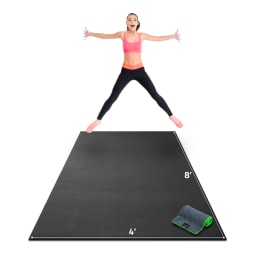
Pros
- Non-toxic materials
- Shock-absorbing
- Non-slip, double-sided design keeps it in place
- Portable
Cons
- May need rug anchors if used over carpet
Material: Rubber
Price per square foot: $6.67
This freestanding exercise mat is specifically designed to protect your joints and your floors when you’re busting out burpees and other high-impact moves. It’s made with non-toxic rubber and has a firm but cushioning feel and a no-slip grip. Plus, it’s available in a range of spacious sizes to suit your space.
At one-quarter inch thick, these mats offer the absorption you want during high-impact workouts. And since they roll right up when you’re done, they quite literally turn any room in your home into a usable gym space.
Advertisement
This ad is displayed using third party content and we do not control its accessibility features.
Best for cardio equipment: iCork Floor Cork Floating Flooring
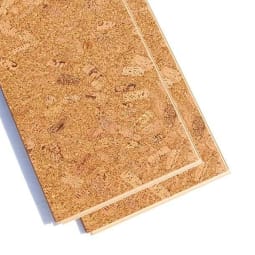
Pros
- Eco-friendly
- Great flex and shock absorption for heavy equipment
Cons
- Not waterproof and might absorb sweat
Material: Cork
Price per square foot: $4.19
Cork flooring is a stylish and impressively effective choice for home gyms. Not only is it impact-resistant, cushioning, and low-slip, it’s particularly beneficial if you have a treadmill, stationary bike, rower, or another oversized piece of equipment. Cork is smooth and resilient, but it naturally flexes and compresses to absorb shock beautifully. It also insulates nicely against acoustical vibrations to reduce noise, no matter how fast you’re sprinting, stepping, or spinning.
Another bonus: unlike most other flooring materials, cork is a renewable resource that won’t shed microfibers or trap dust. Plus, it’s super easy to keep clean (though it isn’t completely water-resistant).
Best for yoga: Lifeproof Click-Lock Luxury Vinyl Plank Flooring
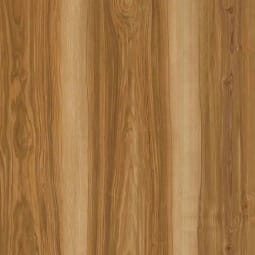
Pros
- Treated to resist odors and stains
- Simple drop-and-lock installation system with pre-attached underlay
- Affordable
Cons
- Requires installation
Material: Vinyl
Price per square foot: $3.49
There’s a reason yoga studios all seem to have the same floor. “Vinyl is the best product for [yoga] because it can be cleaned easily, has a little give underfoot, and is aesthetically pleasing,” says Rish. “You can opt for a lot of different patterns here that look like real wood or stone, which gives you a more biophilic or Zen design aesthetic.”
This option from Lifeproof is antimicrobial to resist mold and mildew. It’s also scratch and stain resistant and waterproof if you’re feeling the Bikram yoga. While you will have to install it, the drop-and-lock system is straightforward. Plus, it can go right over existing tile, wood, concrete, and vinyl floors.
Laminate, hardwood, and even polished concrete also tend to crop up in the yoga world, but Rish still prefers vinyl for its slip resistance, she says. “I would go with something that does not have a beveled edge,” Rish adds. “Dirt likes to make a home in the crevices so save yourself some sanity and make sure it has a flat edge.”
Advertisement
This ad is displayed using third party content and we do not control its accessibility features.
Best for kickboxing: American Floor Mats Ultimate Stand-Alone Gym Mat
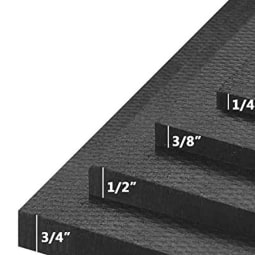
Pros
- Sold in varying thicknesses and sizes
- Stays flat
- Textured surface for good grip
Material: Rubber
Price per square foot: $9
Whether you’re using a heavy bag or following a contact-free cardio kickboxing class, you need a secure base that’s not too slick. “You want a non-slip surface that’s easy to clean, and it needs to be fairly firm (not foamy) to help provide a stable platform to train on,” says Husk. That’s key when you’re throwing both contralateral and ipsilateral combos.
These stand-alone mats are heavy enough to stay put no matter how nasty that left hook/right round gets, and a proprietary manufacturing process ensures they’ll always lay flat—no curling edges here. They come in multiple sizes and thicknesses, and there are even options for a little splash of color.
Best for aerobics: American Floor Mats Extreme Rubber Gym Tiles
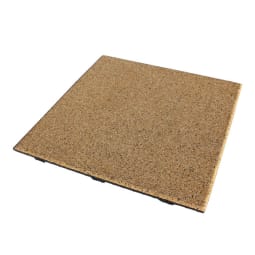
Pros
- Durable
- Highly shock absorbent
Cons
- Expensive
- Only available in a single tile size
Material: Rubber
Price per square foot: $6.75
Prefer your workouts low-impact and high-intensity? These rubber gym tiles will give you a great base for any studio class that leads you through an energetic, calorie-burning workout. The tiles come with a connection piece for a secure fit, which is key when you’re moving quickly through high knees or dance moves. (The last thing you want is your floor coming apart.) The rubber also absorbs shock well and is slip-resistant even when it’s wet, which means no slipping or sliding.
The tiles have a patented wear layer for long-term durability and come with a 15-year warranty.
Advertisement
This ad is displayed using third party content and we do not control its accessibility features.
Best for mobility training: Yes4All Interlocking Exercise Foam Mats

Pros
- Lightweight means quick assembly
- Non-skid and shock absorbing
- Affordable
Cons
- Won’t stay connected under strenuous activity
Material: Foam
Price per square foot: $1
If your fitness focus is mobility training to really work range of motion, this foam flooring is a good pick. It assembles in just minutes to create a supportive, cushioning platform so you can focus on flexibility and strength. Because of its light weight, the interlocking feature is best suited to controlled, intentional movements. It’s also the least expensive option on our list, which is always a bonus.
What to know about putting down a new floor.
When you’re putting down your new home gym flooring, you’ll want to consider your existing flooring. Here are some pro installation tips depending on the type of floor you’re working with:
- Over concrete: This is an unforgiving surface for high-impact workouts, and if it’s finished, it may also be slick. The good news is that you can put any of the options on our list over a concrete floor, but you’ll want to pick a product that will maintain tight seams if your workouts are high-energy.
- Over carpet: If you’re keeping the carpet, your best bet is to opt for a stand-alone mat that is heavy enough to stay in place through any workout. You may want to opt for rug anchors, too, which are designed to keep things securely in place.
- Over hardwood: This is where you’ll want to protect your investment and keep things flexible for the future, says Rish. That means floating, shock-absorbing surfaces are best.
- Over tile: Tile is another ultra-rigid surface that can also be quite slick. Keep your tile (and your joints!) in good shape with any of the floating or stand-alone picks on our list. But keep in mind that tile can crack easily, especially if you’re dropping heavy weights, so you’ll want to go with a thicker flooring option.
Frequently Asked Questions
How thick should flooring be for home gym?
Ideal thickness will vary depending on the home gym flooring you choose and the workouts you’re planning. A typical yoga mat, for example, is an eighth of an inch in thickness, which is sufficient for low-impact movements. If you’re flinging around heavy weights or doing high-impact exercises, a quarter-inch to half-inch depth will protect your joints and your floor while also offering some shock absorption and minimizing vibrations from big pieces of exercise equipment.
Is foam or rubber better for home gym floor?
Rish recommends rubber over foam for better performance. “It’s just a better product. It’s heavier and slides less,” she says. “Plus, you can pick the floating kind up at most warehouses or big-box stores.”
Is carpet OK for home gym?
It really depends on your workout and how much support the carpet and pad offer. Even so, there are likely better options. “Carpet would be our least favorite as it stains, traps odor, and allows for difficult rooting of the feet,” points out Fischer.
The takeaway.
When it comes to your home gym, the floor deserves as much thought as the rest of your gear. The more tailored it is to your specific at-home workouts, the better. “I personally find it easier to commit to a workout at home if it is aesthetically pleasing and already set up for me,” says Rish. “Having a dedicated space for you to do your thing will help you choose fitness over anything else.”

